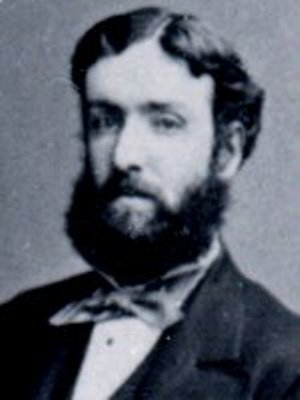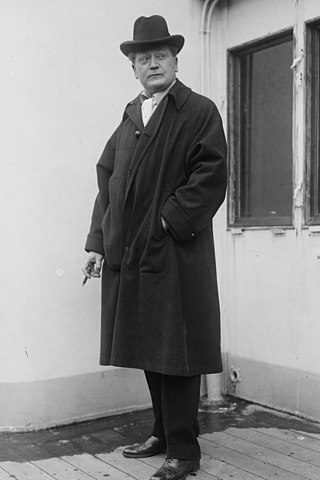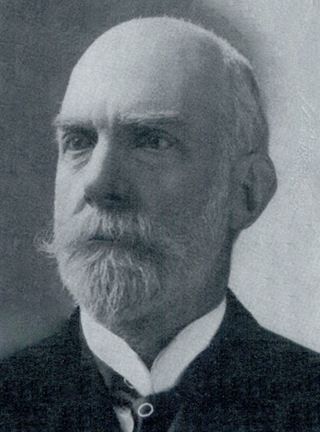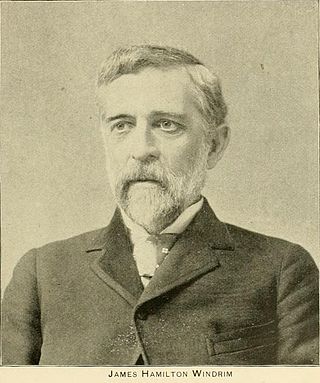Related Research Articles

Louis Henry Sullivan was an American architect, and has been called a "father of skyscrapers" and "father of modernism." He was an influential architect of the Chicago School, a mentor to Frank Lloyd Wright, and an inspiration to the Chicago group of architects who have come to be known as the Prairie School. Along with Wright and Henry Hobson Richardson, Sullivan is one of "the recognized trinity of American architecture." The phrase "form follows function" is attributed to him, although he credited the concept to ancient Roman architect Vitruvius. In 1944, Sullivan was the second architect to posthumously receive the AIA Gold Medal.

Victorian architecture is a series of architectural revival styles in the mid-to-late 19th century. Victorian refers to the reign of Queen Victoria (1837–1901), called the Victorian era, during which period the styles known as Victorian were used in construction. However, many elements of what is typically termed "Victorian" architecture did not become popular until later in Victoria's reign, roughly from 1850 and later. The styles often included interpretations and eclectic revivals of historic styles (see Historicism). The name represents the British and French custom of naming architectural styles for a reigning monarch. Within this naming and classification scheme, it followed Georgian architecture and later Regency architecture, and was succeeded by Edwardian architecture.

Richard Morris Hunt was an American architect of the nineteenth century and an eminent figure in the history of American architecture. He helped shape New York City with his designs for the 1902 entrance façade and Great Hall of the Metropolitan Museum of Art, the pedestal of the Statue of Liberty, and many Fifth Avenue mansions since destroyed.

Carrère and Hastings, the firm of John Merven Carrère and Thomas Hastings, was one of the outstanding American Beaux-Arts architecture firms. Located in New York City, the firm practiced from 1885 until 1929, although Carrère died in an automobile accident in 1911.

Bruce Price was an American architect and an innovator in the Shingle Style. The stark geometry and compact massing of his cottages in Tuxedo Park, New York, influenced Modernist architects, including Frank Lloyd Wright and Robert Venturi.
Ross and Macdonald was one of Canada's most notable architecture firms in the early 20th century. Based in Montreal, Quebec, the firm originally operated as a partnership between George Allen Ross and David MacFarlane from 1907 to 1912. MacFarlane withdrew from the firm in 1912, and Robert Henry Macdonald became a partner.

Warren and Wetmore was an architecture firm in New York City which was a partnership between Whitney Warren (1864–1943) and Charles Delevan Wetmore, that had one of the most extensive practices of its time and was known for the designing of large hotels.
Cross & Cross (1907–1942) was a New York City-based architectural firm founded by brothers John Walter Cross and Eliot Cross.

Whitney Warren was an American Beaux-Arts architect who founded, with Charles Delevan Wetmore, Warren and Wetmore in New York City, one of the most prolific and successful architectural practices in the US.

George Edward Harney (1840–1924) was a late 19th-century American architect based in New York City.

Wilson Brothers & Company was a prominent Victorian-era architecture and engineering firm established in Philadelphia, Pennsylvania. The company was regarded for its structural expertise. The brothers designed or contributed engineering work to hundreds of bridges, railroad stations and industrial buildings, including the principal buildings at the 1876 Centennial Exposition. They also designed churches, hospitals, schools, hotels and private residences. Among their surviving major works are the Pennsylvania Railroad, Connecting Railway Bridge over the Schuylkill River (1866–67), the main building of Drexel University (1888–91), and the train shed of Reading Terminal (1891–93), all in Philadelphia.

Elmer H. Fisher was an architect best known for his work during the rebuilding of the American city of Seattle after it was devastated by fire in 1889. He began his career as a carpenter and migrated from Massachusetts to the Pacific Northwest, where he practiced architecture from 1886 to 1891. After his reputation was damaged by litigation and personal scandal in Seattle, he relocated to Los Angeles in 1893, where he only had modest success as an architect before returning to carpentry, dying around 1905 with his final years almost as mysterious as his early years; the details of his death and his burial location remain unknown. His commercial building designs played a major role in reshaping Seattle architecture in the late 19th century and many still survive as part of the Pioneer Square Historic District.

William Gibbons Preston was an American architect who practiced during the last third of the nineteenth century and in the first decade of the twentieth. Educated at Harvard University and the École des Beaux-Arts in Paris., he was active in Boston, New York, Rhode Island, Ohio, New Brunswick and Savannah, Georgia, where he was brought by George Johnson Baldwin to design the Chatham County courthouse. Preston stayed in Savannah for several years during which time designed the original Desoto Hotel, the Savannah Volunteer Guards Armory and 20 other distinguished public buildings and private homes. He began his professional career working for his father, the builder and architect Jonathan Preston (1801–1888), upon his return to the United States from the École in 1861, and was the sole practitioner in the office from the time his father retired c. 1875 until he took John Kahlmeyer as a partner in about 1885.
William Boone was an American architect who practiced mainly in Seattle, Washington from 1882 until 1905. He was one of the founders of the Washington State chapter of the American Institute of Architects as well as its first president. For the majority of the 1880s, he practiced with George Meeker as Boone and Meeker, Seattle's leading architectural firm at the time. In his later years he briefly worked with William H. Willcox as Boone and Willcox and later with James Corner as Boone and Corner. Boone was one of Seattle's most prominent pre-fire architects whose career lasted into the early 20th century outlasting many of his peers. Few of his buildings remain standing today, as many were destroyed in the Great Seattle fire including one of his most well known commissions, the Yesler – Leary Building, built for pioneer Henry Yesler whose mansion Boone also designed. After the fire, he founded the Washington State chapter of the American Institute of Architects and designed the first steel frame office building in Seattle, among several other large brick and public buildings that are still standing in the Pioneer Square district.

Robert W. Gibson, AIA, was an English-born American ecclesiastical architect active in late-nineteenth- and early-twentieth-century New York state. He designed several large Manhattan churches and a number of prominent residences and institutional buildings.

James Hamilton Windrim was a Philadelphia architect who specialized in public buildings, including the Masonic Temple in Philadelphia and the U.S. Treasury. A number the buildings he designed are on the National Historic Landmarks and/or the National Register of Historic Places, including the Masonic Temple in Philadelphia and the National Savings and Trust Company building in Washington, DC.

Alfred J. R. E. Zucker was a German-American architect, who worked in Galveston, Texas, Mississippi, New York City, and Buenos Aires.

George DeWitt Mason was an American architect who practiced in Detroit, Michigan, in the latter part of the 19th and early decades of the 20th centuries.

Albert W. Fuller (1854-1934) was an American architect practicing in Albany, New York.
Robert Campbell Dixon Jr. was a prominent architect around the turn of the 20th century, who contributed to many of the notable public buildings in and around New York City and Hudson County, New Jersey. Dixon, Frequently referred to as R. C. Dixon in historical documents, is understood to not be the same Robert Dixon that designed many of Brooklyn Heights' characteristic Brownstone homes circa 1890. In 1898 R.C. Dixon was listed as being in Union Hill, NJ whereas Robert Dixon was listed as operating from 213 Montague Street, in Brooklyn.
References
- 1 2 3 4 History and Commerce of New York - 1891. New York: American Publishing and Engraving Co. 1891. p. 174.
- 1 2 Directory of Architects and Classified Directory of First Hands in the Building Trades: Issued Annually. 1890. ... 1890. p. 29.
- ↑ Laws Relating to Buildings in the City of New York: With Marginal Notes, a Complete Index, and Colored Engravings. II. Law Limiting the Height of Dwelling-houses, in the City of New York. III. Laws Relating to the Extinction and Prevention of Fire, and Explosives and Combustible Materials in Buildings in the City of New York. IV. Laws Relating to Tenement and Lodging Houses in the City of New York. Regulations of Health Department for Light and Ventilation, with Illustrations. V. Mechanic's Lien Law for the City of New York. VI. An Act for the Protection of Life and Limb. Record and Guide. 1887. pp. 184.
- ↑ Brodie, Antonia; Library, British Architectural; Architects, Royal Institute of British (2001-12-20). Directory of British Architects, 1834-1914: Vol. 2 (L-Z). A&C Black. p. 693. ISBN 978-0-8264-5514-7.
- ↑ Griswold, A. Whitney; Shepardson, Whitney H.; Scroggs, William O.; Toynbee, Arnold J.; Boulter, V. M. (June 1936). "The United States in World Affairs in 1934-1935". Pacific Affairs. 9 (2): 301. doi:10.2307/2751429. ISSN 0030-851X. JSTOR 2751429.